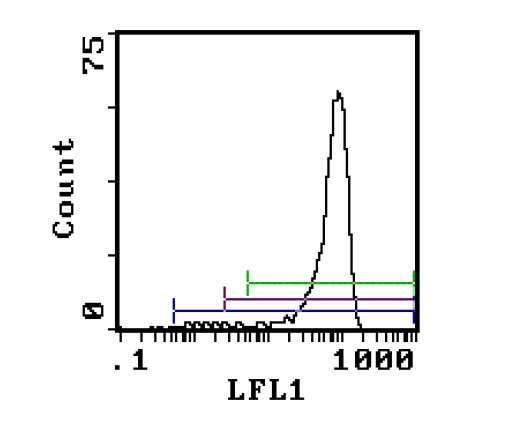Ly6g Rat Monoclonal Antibody [Clone ID: RB6-8C5]
Specifications
| Product Data | |
| Clone Name | RB6-8C5 |
| Applications | CT, FC, IHC, WB |
| Recommended Dilution | This antibody is suitable for studies of myeloid differentiation stages and their regulations by cytokines. Applications include Flow Cytometry (1,2,3) complement-mediated depletion (4), Western blot staining (5) and both Frozen and Paraffin Sections (6). |
| Reactivities | Mouse |
| Host | Rat |
| Isotype | IgG2b |
| Clonality | Monoclonal |
| Specificity | This monoclonal antibody reacts with the myeloid differentiation antigen Gr-1. (1,2). This 25-30 kDa cell surface antigen is expressed on myeloid cells but not lymphoid or erythroid cells. The expression of the Gr-1 antigen increases with granulocyte maturation (3) as shown by the distinct populations of bone-marrow cells this monoclonal antibody labels: negative, low positive and high positive. Expression is transient on cells of monocytic lineage (3). |
| Formulation | PBS State: Purified State: Liquid purified IgG fraction Preservative: 0.02% Sodium Azide |
| Concentration | 1.0 mg/ml |
| Purification | Protein G Chromatography |
| Gene Name | lymphocyte antigen 6 complex, locus G |
| Database Link | |
| Background | The Gr-1 antigen is primarily a marker of myeloid differentiation. In the bone marrow the level of Gr-1 expression is low on immature myeloblasts and increases as the myeloid cells mature to granulocytes. Gr-1 is also expressed on macrophages and transiently on differentiating monocytes. Expression of Gr-1 on a subpopulation of lymphocytes has also been reported. |
| Synonyms | Gr-1 Granulocyte marker |
| Note | Protocol: FLOW CYTOMETRY ANALYSIS: Method: 1. Prepare a cell suspension in media A. For cell preparations, deplete the red blood cell population with cell separation medium. 2. Wash 2 times. 3. Resuspend the cells to a concentration of 2x10e7 cells/ml in media A. Add 50 µl of this suspension to each tube (each tube will then contain 1 x 10e6 cells, representing 1 test). 4. To each tube, add 0.1-0.2 µg* of CL046P. 5. Vortex the tubes to ensure thorough mixing of antibody and cells. 6. Incubate the tubes for 30 minutes at 4°C. 7. Wash 2 times at 4°C. 8. Add 100 µl of secondary antibody FITC Goat anti-rat IgG (H+L) . 9. Incubate tubes at 4°C for 30 - 60 minutes (It is recommended that tubes are protected from light since most fluorochromes are light sensitive). 10. Wash 2 times at 4°C. 11. Resuspend the cell pellet in 50 µl ice cold media B. 12. Transfer to suitable tubes for flow cytometric analysis containing 15 µl of propidium iodide at 0.5 mg/ml in PBS. This stains dead cells by intercalating in DNA. Media: A. Phosphate buffered saline (pH 7.2) + 5% normal serum of host species + sodium azide (100 µl of 2M sodium azide in 100 mls). B. Phosphate buffered saline (pH 7.2) + 0.5% Bovine serum albumin + sodium azide (100 µl of 2M sodium azide in 100 mls). Results-Tissue Distribution: Mouse Strain: BALB/c Cell Concentration: 1x10e6 cells per test Antibody Concentration Used: 0.1 µg/10e6 cells Isotypic Control: Rat IgG2b Cell Source-Percentage of cells stained above control: Thymus: 2.0% Whole Blood Monocytes: 79.1% Bone Marrow Macrophages: 87.5% N.B. Appropriate control samples should always be included in any labelling studies. * For optimal results in various applications, it is recommended that each investigator determine dilutions appropriate for individual use. Strain Distribution by Flow Cytometry Analysis: Cell Concentration: 1x10e6 cells per test Antibody Concentration Used: 0.1 µg/10e6 cells Strains Tested: BALB/c, C57BL/6, CBA, C3H/He, AKR Positive: BALB/c, C57BL/6, CBA, C3H/He, AKR Negative: none |
| Reference Data | |
Documents
| Product Manuals |
| FAQs |
| SDS |
{0} Product Review(s)
0 Product Review(s)
Submit review
Be the first one to submit a review
Product Citations
*Delivery time may vary from web posted schedule. Occasional delays may occur due to unforeseen
complexities in the preparation of your product. International customers may expect an additional 1-2 weeks
in shipping.






























































































































































































































































 Germany
Germany
 Japan
Japan
 United Kingdom
United Kingdom
 China
China



